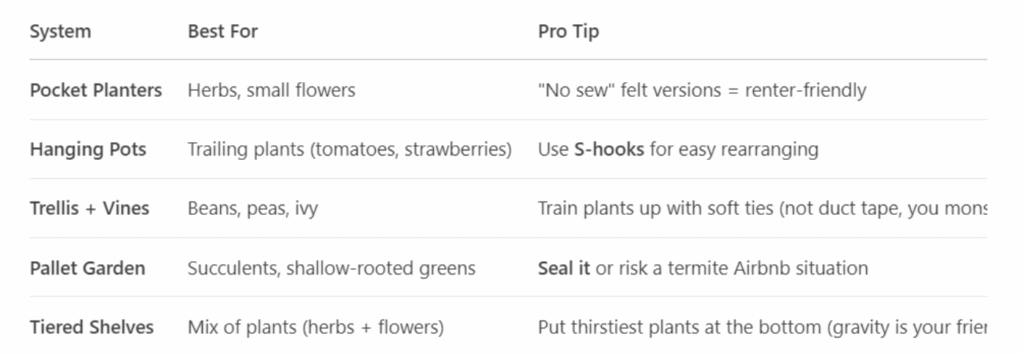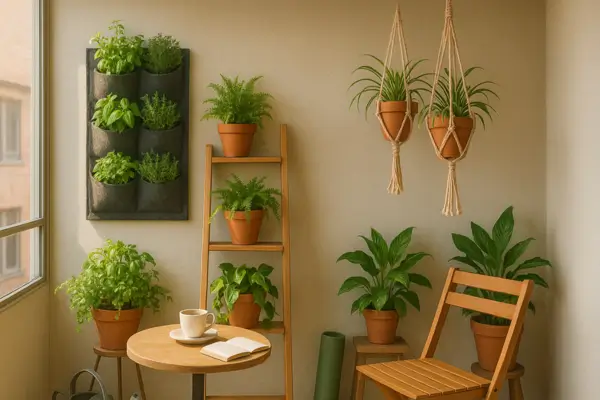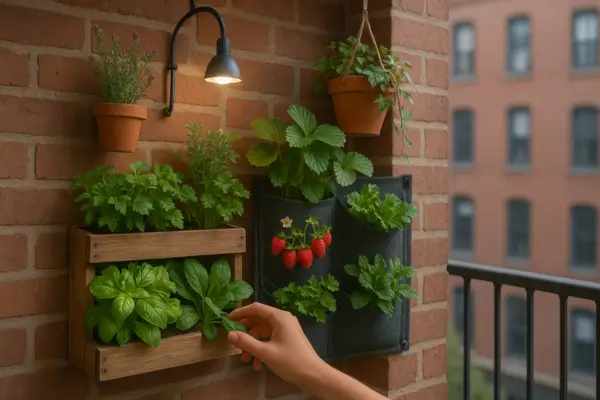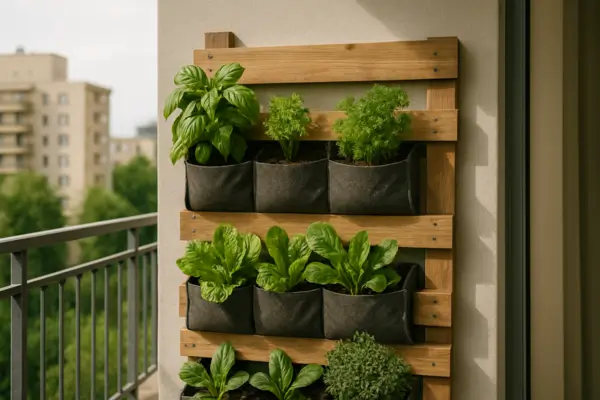Introduction:
Hey there, city gardener! 🌿 Dreaming of growing your own plants but think your studio apartment or postage-stamp balcony is too small? Think again! Vertical gardening is about to become your new best friend—it’s like giving your plants a high-rise apartment of their own.
Why Go Vertical?
Let’s be real—urban living often means choosing between a couch or a coffee table, let alone a garden. But with vertical gardening:
- You’ll save space like a Tetris champion—grow up instead of out on walls, railings, or even that weird empty corner by the AC unit.
- Your air will feel fresher (goodbye, mysterious city smells!) because plants are nature’s air purifiers.
- Your Instagram feed will level up—nothing beats a lush green wall as your Zoom background.
- No more backaches! Say goodbye to crouching—just reach out and water your hanging herb babies.
Whether you’re a black-thumbed beginner or a wannabe plant parent with big dreams (yes, you can grow cherry tomatoes on a fire escape), this guide will help you build a vertical garden that fits your space—and your vibe.
Ready to turn your urban jungle dreams into reality? Let’s do this! 🌱
(P.S. If you kill a plant or two along the way—welcome to the club. We’ve all been there.)
1. Why Choose a Vertical Garden? (Because Tiny Apartments Deserve Love Too!)
Look, we get it—when your “outdoor space” is basically a windowsill and a dream, traditional gardening feels like a cruel joke. But that’s where vertical gardens swoop in like plant superheroes! Here’s why you’ll obsess over going vertical:
Space Efficiency: Gardening for the “500 Sq. Ft. or Less” Crowd
- Turn blank walls into edible masterpieces—your basil and strawberries don’t care if they grow sideways.
- Balcony? Fire escape? A lone shelf? Perfect. Vertical gardens thrive in awkward nooks that regular plants would side-eye.
- No yard? No problem. Your garden now lives where your landlord forgot to charge extra for.
Improved Air Quality: Because City Air is Questionable
- Plants are basically nature’s air purifiers—they’ll filter out dust, toxins, and that mysterious “what’s-that-smell” vibe from the street below.
- More greens = more oxygen. Translation: Your apartment will feel less like a shoebox and more like a spa (or at least a spa’s parking lot).
Aesthetic Appeal: Instant “I Have My Life Together” Vibes
- Cover up that sad, peeling wall with a living tapestry of herbs, flowers, or trailing vines.
- Goodbye, “sterile apartment complex” look. Hello, “I’m a person who definitely remembers to water my plants” energy.
- Pro tip: A vertical garden is the cheapest (and most alive) wall art you’ll ever own.
Easy Access & Maintenance: For the Lazy Gardener in All of Us
- No bending! Water and prune at eye level—your knees will thank you.
- Fewer weeds (because where would they even fit?).
- Modular systems mean you can start small (one pot of mint) and expand like a plant-powered empire.
Bonus Perk: Instant Bragging Rights
- “Oh, this old thing? Just my wall of homegrown arugula.”
- Friends will ooh and aah while secretly wondering why their succulents keep dying.
Bottom line: Vertical gardens are the ultimate urban hack—they’re practical, pretty, and proof that you don’t need a backyard to grow your own oasis.
(Next up: How to actually build one without accidentally flooding your downstairs neighbor’s apartment…)
2. Planning Your Vertical Garden (So You Don’t End Up With a Leaning Tower of Dead Plants)
Alright, green thumb wannabe, before you start drilling holes in your rental’s walls (security deposit, anyone?), let’s plan this jungle properly. Because nothing’s sadder than a sun-starved herb graveyard or a wind-whipped tomato tragedy.
Step 1: Assess Your Space Like a Plant Detective
☀️ Sunlight Audit:
- Full sun (6+ hours)? Congrats, you’re growing tomatoes, peppers, and herbs like a champ.
- Shady AF? Stick to mint, spinach, or ferns—they’re basically the vampires of the plant world.
- Indoors? Get a grow light or embrace your destiny as a “low-light plant whisperer” (snake plants, pothos).
💨 Wind Check:
- Balcony on the 20th floor? RIP flimsy plants. Go for sturdy stuff like rosemary or succulents.
- Calm indoor corner? Delicate herbs (looking at you, cilantro) will thrive.
🏗️ Structural Integrity Test:
- Rental walls: Assume they’re made of papier-mâché. Use freestanding systems or tension rods.
- Outdoor fence? Make sure it won’t collapse under the weight of your watermelon dreams.
Step 2: Choose Your Battleground (a.k.a. Location)
Option A: The Balcony Jungle
- Pros: Sun! Rain! Fresh air!
- Cons: Your neighbors will judge your kale obsession.
Option B: Indoor Green Wall
- Pros: Instagrammable 24/7.
- Cons: Requires actual watering (RIP, “I’ll do it later” mentality).
Option C: Fence or Railing Farm
- Pros: Zero floor space used.
- Cons: Squirrels may declare war on your strawberries.
Step 3: Pick Your Weapon (Vertical Garden System)

Real Talk:
- Start small. One thriving wall planter > a chaotic, half-dead jungle.
- Drainage is non-negotiable. Nobody wants a moldy wall.
- Check weight limits. Waterlogged soil is heavy—your IKEA shelf will rebel.
Up Next: We’ll talk plant picks (including the “I-never-water-these” hall of fame).
3. Picking Your Vertical Garden All-Stars (Plants That Won’t Ghost You)
Let’s be real—not all plants are cut out for the vertical life. Some are divas (looking at you, orchids), while others thrive in the upside-down jungle like they were born for it. Here’s your no-BS guide to choosing plants that actually work in vertical gardens, sorted by personality type:
1. The Kitchen MVPs: Herbs
(For people who want their plants to pull double duty)
🌿 Basil – Grows like it’s on steroids (just pinch off flowers to keep it bushy).
🌿 Mint – Will survive nuclear winter (but plant it alone—it bullies other herbs).
🌿 Thyme – Drought-tolerant and smells like a fancy Italian restaurant.
🌿 Oregano – The “set it and forget it” herb.
🌿 Chives – Cute, onion-y, and impossible to kill.
Best for: Hanging pockets, small wall planters.
Pro Tip: Snip herbs often—they grow back thicker (like a bad haircut, but better).
2. The Fast & the Delicious: Leafy Greens
(For impatient gardeners who want quick results)
🥬 Lettuce (Buttercrunch, Romaine) – Ready in 30 days. Basically the fast food of gardening.
🥬 Spinach – Grows in shade like it’s hiding from the sun.
🥬 Kale – The gym bro of greens (gets tougher the more you harvest it).
🥬 Swiss Chard – Colorful stems = instant garden glam.
Best for: Tiered planters, vertical gutters.
Pro Tip: Harvest outer leaves first—the plant keeps growing like a zombie that won’t die.
3. The Drama Queens: Flowering Plants
(For those who need a little ~flair~ in their life)
🌸 Petunias – Bloom nonstop (if you deadhead them, which is just fancy for “pluck the dead flowers”).
🌸 Begonias – Thrive in shade and come in obnoxiously pretty colors.
🌸 Nasturtiums – Edible flowers that taste peppery (and grow like weeds).
🌸 Pansies – Cute, cold-tolerant, and basically the puppy of flowers.
Best for: Cascading planters, trellis accents.
Warning: These guys are thirstier than your friend after a night out.
4. The Survivors: Succulents & Air Plants
(For people who forget plants exist for weeks at a time)
🌵 Succulents (Echeveria, Sedum) – Store water in their leaves like tiny plant camels.
🌵 Air Plants (Tillandsia) – No soil needed (just mist them occasionally and they’re happy).
🌵 String of Pearls – Looks like a living beaded curtain (and thrives on neglect).
Best for: Vertical frames, mounted boards, or literally any surface.
Pro Tip: If you kill these… maybe stick to fake plants.
Plants to AVOID in Vertical Gardens:
🚫 Big root veggies (carrots, potatoes) – They need deep soil (and your vertical planter is not a high-rise for tubers).
🚫 Heavy fruiting plants (giant pumpkins) – Gravity is not your friend here.
🚫 Invasive spreaders (bamboo, some ivy) – Unless you want your wall to look like a scene from Jumanji.
Final Thought:
Mix and match! Try herbs + flowers for pretty & practical, or greens + succulents for low-maintenance chic.
Next up: How to actually plant these bad boys without everything ending up on the floor.
4. Gear Up: The Must-Have Tools for Your Vertical Garden (No PhD in Engineering Required)
So you’ve picked your plants—now what? Before you MacGyver a garden out of duct tape and wishful thinking, here’s the real-deal toolkit you’ll need to build a vertical garden that won’t collapse, drown, or starve your plants.
1. Containers: Where Your Plants Will Live Their Best Life
(Because “just sticking them in the wall” is how horror movies start)
Budget-Friendly Options:
- Felt pocket planters – Perfect for herbs & strawberries (and renters!).
- PVC pipes (cut lengthwise) – Urban farm vibes on the cheap.
- Wooden crates – Rustic charm (sand them so you don’t get splinters in your spinach).
Aesthetic Upgrade Picks:
- Geometric wall planters – For the “I want my garden to look like modern art” crowd.
- Self-watering wall pots – Great for forgetful waterers (we see you).
DIY Daredevil Options:
- Gutters – Yes, like the ones on your roof. Mount them horizontally.
- Shoe organizers – The $10 vertical garden hack (just poke drainage holes).
Pro Tip: Match container depth to your plants’ roots. Shallow pockets = herbs/succulents. Deeper pots = kale, chard.
2. Soil & Fertilizer: Not Just Dirt
(Your plants deserve better than that mystery soil from the alley.)
🌱 Lightweight potting mix – Heavy soil = collapsing wall. Look for “vertical garden” or “container mix.”
🌱 Perlite or vermiculite – Keeps soil airy (prevents roots from suffocating).
🌱 Slow-release fertilizer – Like a multivitamin for plants (no daily remembering needed).
🚫 Avoid:
- Garden soil (too dense, may contain pests).
- Miracle-Gro in small pots (can burn roots—dilute it!).
3. Irrigation: Because Hand-Watering Gets Old Fast
*(Unless you enjoy climbing chairs with a watering can.)_
💧 Drip irrigation kit – Connects to a timer (set it and forget it).
💧 Self-watering planters – Reservoir at the bottom = no over/underwatering.
💧 Watering spikes – For when you’re out of town (or just lazy).
Hack: Place thirstier plants at the bottom—gravity will help water trickle down.
4. Support Structures: The Backbone of Your Garden
*(Without these, your garden is just a pile of sad plants on the floor.)_
🛠️ Trellises – For climbers like beans, peas, or ivy.
🛠️ Wire grids – Lets you rearrange pots easily.
🛠️ Mesh/netting – Great for lightweight setups (like succulents).
Pro Tip: Use S-hooks for adjustable heights—plants grow, so should your setup.
Bonus: Tools You Didn’t Know You Needed
- Cordless drill – For making drainage holes (or explaining to your landlord why there are holes in the wall).
- Waterproof backing – Unless you want a moldy wall (use a rubber mat or pond liner).
- Zip ties – The duct tape of gardening.
Final Checklist Before You Start:
✅ Drainage holes – In every. Single. Container.
✅ Wall anchors – If attaching to drywall (command hooks have limits, people).
✅ Tray at the bottom – Catches runoff (your downstairs neighbor will thank you).
Next Up: Step-by-step assembly (with pictures, because words are hard).
5. Let’s Build It! Your Foolproof Vertical Garden Step-by-Step
So you’ve got your plants, your tools, and a dream—now it’s time to turn that blank wall into a living masterpiece. Follow these steps carefully (or don’t, and learn from my mistakes—your call).
Step 1: Prep Like a Pro (No Leaks Allowed)
For Outdoor Walls/Fences:
✔️ Check for rot/mold – If the wall crumbles when you poke it, abort mission.
✔️ Add a waterproof barrier – Use a plastic sheet or pond liner between the wall and planters.
For Indoors:
✔️ Protect your drywall – Stick on waterproof vinyl panels (or say hello to mold).
✔️ Put down a drip tray – Unless you enjoy mopping up soil runoff daily.
Pro Tip: If renting, use freestanding systems (tension rods, shelves) instead of drilling.
Step 2: Install Your Vertical System (Without It All Crashing Down)
Option A: Hanging Pocket Planters
- Mount heavy-duty hooks into studs (not just drywall!).
- Hang the felt pockets and adjust for even spacing.
Option B: Wall-Mounted Shelves/Trellis
- Secure L-brackets or a trellis frame to the wall.
- Attach pots or trays with zip ties or S-hooks.
Option C: DIY Pallet Garden
- Sand & seal the pallet (unless you love splinters).
- Line the back with landscape fabric to hold soil.
- Staple or nail in place.
Safety Check: Give it a firm shake test—if it wobbles, reinforce it.
Step 3: Plant Like You Mean It
- Fill containers ¾ with potting mix (don’t pack it down—roots need air!).
- Gently remove plants from nursery pots (no yanking!).
- Place in pockets/pots and fill gaps with more soil.
- Press lightly to secure (plants shouldn’t wiggle like loose teeth).
Pro Tip:
- Put thirsty plants at the bottom (water trickles down).
- Leave 2-3 inches between plants—they grow, I promise.
Step 4: Watering System Setup (Because You Will Forget)
Low-Tech Method:
- Watering can with a long spout (target: roots, not leaves).
- Self-watering spikes (great for vacations).
High-Tech Method:
- Drip irrigation kit on a timer (set it for early morning).
- Reservoir system (for wall planters with built-in tanks).
Golden Rule: Water until it drains out the bottom—shallow watering = weak roots.
Step 5: Keep It Alive (The Hard Part)
🌱 Week 1: Check daily—soil should stay damp, not soggy.
✂️ Week 2: Prune yellow leaves (they’re not coming back to life).
🌿 Month 1: Fertilize (liquid seaweed or slow-release pellets).
Troubleshooting:
- Droopy plants? Could be over or under-watered (poke the soil to check).
- Pests? Spray with soapy water or neem oil (not Raid, unless you want dead plants).
Final Thought:
Your first try might not be Pinterest-perfect, but it’ll be yours. Start small, learn, and expand!
Up Next: Creative ideas to level up your vertical garden game!
6. Keep It Alive: Maintenance Secrets for a Thriving Vertical Garden
So your vertical garden is up and growing—nice work! But now comes the real test: keeping it alive longer than your last houseplant. Here’s your no-nonsense guide to maintenance that actually works (without turning you into a full-time plant butler).
💧 Watering: The Goldilocks Rule
*(Not too much, not too little—just right.)_
Do This:
✔️ Check soil daily—poke a finger in. If the top inch is dry, it’s time to water.
✔️ Use a drip system (or self-watering planters) for consistent moisture.
✔️ Water in the morning—less evaporation, happier plants.
Avoid This:
🚫 Soaking leaves (wet foliage = mold party).
🚫 Letting pots sit in water (root rot doesn’t RSVP).
Pro Tip: Group plants by thirst level. Herbs like it drier than lettuce.
✂️ Pruning & Harvesting: The “Haircut Method”
*(More snipping = more growing.)_
For Herbs & Greens:
✔️ Pinch off top leaves to encourage bushiness.
✔️ Harvest outer leaves first (let the center keep growing).
For Flowers & Vines:
✔️ Deadhead spent blooms (so the plant focuses on new ones).
✔️ Trim leggy stems to prevent a straggly mess.
Pro Tip: Use clean scissors—dirty tools spread disease like office colds.
🐜 Pest Control: Natural Warfare
*(Because chemicals are for people who don’t eat their own herbs.)_
DIY Remedies:
🌿 Neem oil spray (1 tsp neem + 1L water + a few drops of dish soap).
🌿 Garlic/chili water (blend, strain, spray—bugs hate it).
🌿 Ladybugs (nature’s pest control—order online!).
Common Culprits:
- Aphids? Blast them off with water.
- Spider mites? Wipe leaves with rubbing alcohol.
- Slugs? Sprinkle crushed eggshells around pots.
Prevention Tip: Healthy plants resist pests better—keep them fed and stress-free.
🌦️ Seasonal Care: Adapt or Die (Literally)
Summer:
☀️ Shade delicate greens during heatwaves.
☀️ Water more frequently (containers dry out fast).
Winter:
❄️ Move frost-sensitive plants indoors.
❄️ Switch to cold-hardy greens (kale, spinach).
Spring/Fall:
🍂 Rotate plants based on light changes.
🍂 Refresh soil between growing seasons.
🚨 Emergency SOS: Quick Fixes for Common Disasters
“My plants look sad after vacation!”
→ Trim dead parts, water deeply, and whisper apologies.
“Everything’s covered in white fuzz!”
→ Reduce watering, improve airflow, spray with diluted hydrogen peroxide (1:4 ratio with water).
“Something’s eating my plants but I can’t see bugs!”
→ Check under leaves at night with a flashlight (many pests are nocturnal).
Final Tip: The Lazy Gardener’s Mindset
- Set reminders on your phone for water/fertilizer.
- Start small—10 thriving plants > 50 struggling ones.
- Celebrate the survivors (some plants just weren’t meant for you).
Next Up: Creative ways to expand your vertical garden (because addiction is real).
7. Genius Vertical Garden Hacks for Tiny Spaces
(Because “I don’t have room” is no excuse anymore!)
You’ve mastered the basics—now let’s get wildly creative with vertical gardens that turn “small space struggles” into jaw-dropping greenery. These ideas are cheap, easy, and perfect for renters!
1. Hanging Shoe Organizer Garden
(For the ultimate lazy gardener)
How To:
- Grab a $10 fabric shoe organizer (the kind with pockets).
- Fill each pocket with potting mix + herbs/strawberries.
- Hang on a balcony railing or wall (use S-hooks).
Best Plants: Mint, basil, lettuce, succulents.
Pro Tip: Poke drainage holes in each pocket with scissors.
Why It Rocks:
✔️ Stores 24 plants in 1 sq. ft.
✔️ Folds up when you move
✔️ Looks surprisingly chic (for a shoe organizer)
2. Pallet Garden
(The hipster classic)
How To:
- Find a free pallet (check behind grocery stores).
- Sand it down (splinters = bad).
- Staple landscape fabric to the back/sides.
- Fill with soil and plant succulents or herbs.
Best Plants: Sedum, thyme, strawberries.
Pro Tip: Lean it against a wall or mount horizontally for a shelf effect.
Why It Rocks:
✔️ Zero dollars if you scavenge materials
✔️ Perfect for renters (no permanent damage)
✔️ Insta-worthy rustic vibes
3. Ladder Shelf Planters
(For the “I want my garden to look like a boutique” crowd)
How To:
- Repurpose an old wooden ladder (or buy a cheap shelf).
- Place pots on each rung—mix herbs, flowers, and trailing vines.
- Add fairy lights for nighttime magic.
Best Plants: Pothos, petunias, rosemary.
Pro Tip: Use S-hooks to hang smaller pots at different heights.
Why It Rocks:
✔️ Adjustable spacing as plants grow
✔️ Doubles as decoration
✔️ Easy to move for cleaning
4. Indoor Hydroponic Wall
(For tech-loving plant nerds)
How To:
- Buy a modular hydroponic system (like a vertical Tower Garden).
- Or DIY with PVC pipes + a water pump.
- Grow lettuce, herbs, or cherry tomatoes without soil.
Best Plants: Basil, kale, bok choy.
Pro Tip: Start with a small countertop version before committing to a wall.
Why It Rocks:
✔️ Grows 2x faster than soil gardens
✔️ No dirt = no mess indoors
✔️ Looks like you live in the future
Bonus: 3 Weird-but-Working Ideas
- Gutter Garden: Mount rain gutters horizontally and plant strawberries.
- Teacup Wall: Hang thrift store teacups with succulents.
- Bottle Wall: Cut plastic bottles in half and mount sideways.
Final Tip: Start Small, Dream Big
Pick one hack to try this weekend. Even a single herb pocket counts as a win!
Conclusion:
Your Tiny Urban Jungle Awaits!
Let’s be real—city living often means choosing between a couch or a coffee table, not a sprawling garden. But vertical gardening? It’s the ultimate cheat code. You don’t need a backyard to grow fresh herbs, bright flowers, or even your own salad fixings. All you need is a wall, a balcony, or even just a sunny windowsill.
Why Vertical Gardening Wins for Urban Life:
✔️ Fits anywhere – No yard? No problem.
✔️ Boosts your mood (and air quality) – Plants > concrete views.
✔️ Easy to start – A single hanging planter counts as a win.
✔️ Insta-worthy – Because #UrbanJungle vibes never get old.
Your Next Steps:
- Start small – Try one herb pocket or a single trellis.
- Experiment fearlessly – Killed a plant? Congrats, you’re now a gardener (we’ve all been there).
- Expand slowly – Add more greens as you get the hang of it.
Now It’s Your Turn!
📸 Show off your setup! Drop a photo of your vertical garden in the comments—we want to see your creativity (even if it’s just a shoe organizer with three basil plants).
❓ Stuck? Ask questions below! (Example: “How do I keep my cat from treating my vertical garden like a salad bar?”)
Remember: Every lush green wall started with a single plant. Yours will too. Happy planting! 🌿



